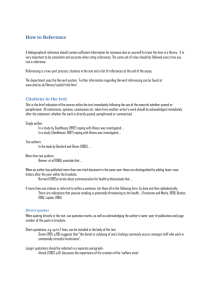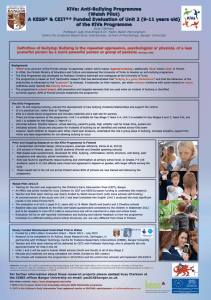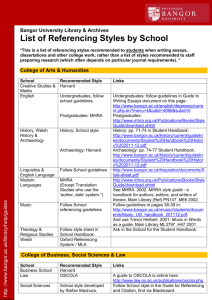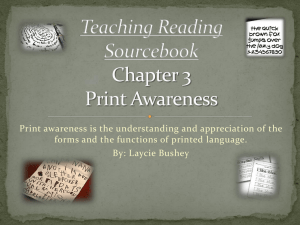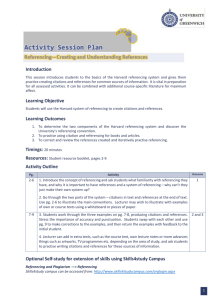Harvard referencing style
advertisement
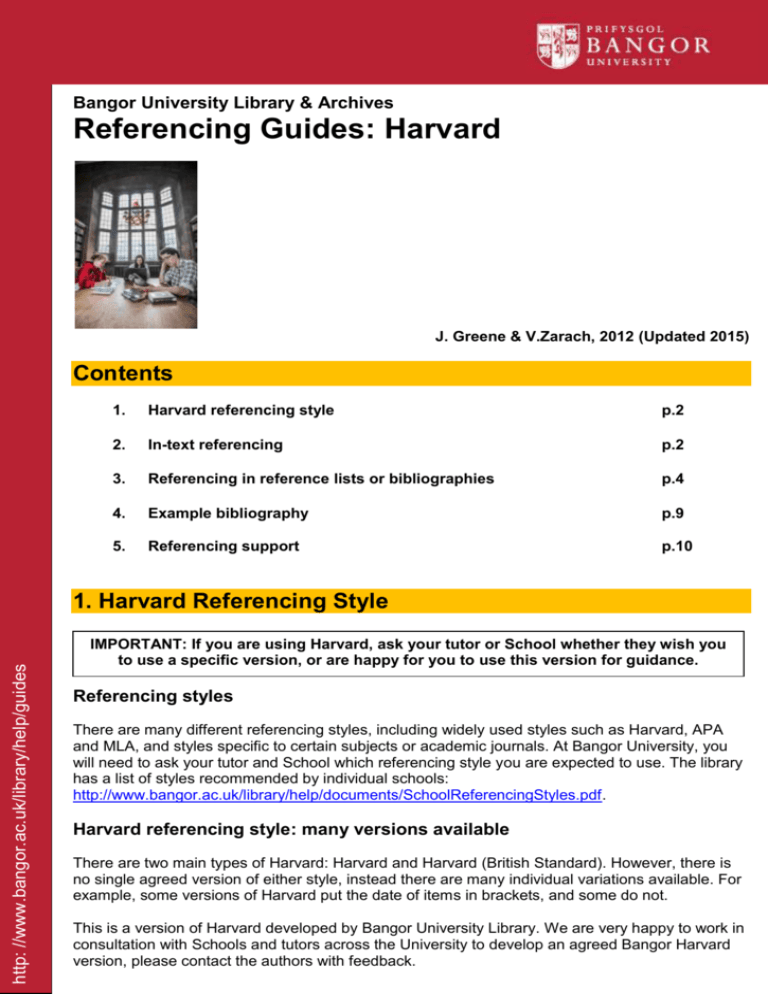
1 Bangor University Library & Archives Referencing Guides: Harvard J. Greene & V.Zarach, 2012 (Updated 2015) Contents 1. Harvard referencing style p.2 2. In-text referencing p.2 3. Referencing in reference lists or bibliographies p.4 4. Example bibliography p.9 5. Referencing support p.10 http: //www.bangor.ac.uk/library/help/guides 1. Harvard Referencing Style IMPORTANT: If you are using Harvard, ask your tutor or School whether they wish you to use a specific version, or are happy for you to use this version for guidance. Referencing styles There are many different referencing styles, including widely used styles such as Harvard, APA and MLA, and styles specific to certain subjects or academic journals. At Bangor University, you will need to ask your tutor and School which referencing style you are expected to use. The library has a list of styles recommended by individual schools: http://www.bangor.ac.uk/library/help/documents/SchoolReferencingStyles.pdf. Harvard referencing style: many versions available There are two main types of Harvard: Harvard and Harvard (British Standard). However, there is no single agreed version of either style, instead there are many individual variations available. For example, some versions of Harvard put the date of items in brackets, and some do not. This is a version of Harvard developed by Bangor University Library. We are very happy to work in consultation with Schools and tutors across the University to develop an agreed Bangor Harvard version, please contact the authors with feedback. 2 2. In Text Referencing Referencing authors in the text One author Two authors (plus if quoting, or if relevant, include page number) Scientists have long been concerned that human activities are causing global climate change (Leggett, 1990). Other scholars have made counter-arguments, such as arguing that “long term variations in earth’s temperature are closely associated with variations in the solar cycle length” (Friis-Christensen & Lassen, 1991, p.700). Subsequent scholars claimed that there were flaws in Friis-Christensen’s & Lassen’s graphs linking global warming with solar activity (Laut, 2003; Connor 2009), and “recent studies show that, in the most recent past (at least since approximately 1990), the solar influence on climate has not been a major contributor” (Patti et al., 2010, p.46). Use semicolons to separate references Four or more authors (“et al”) Reference list Connor, S. 2009. Sun sets on sceptics' case against climate change. The Independent, Monday 14th December. Online at: http://www.independent.co.uk/environment/climate-change/sun-sets-onsceptics-case-against-climate-change-1839875.html. Accessed 25th June 2012. Friis-Christensen, E. & Lassen, K. 1991. Length of the solar cycle: an indicator of solar activity closely associated with climate. Science, 254 (5032), pp.698-700. Laut, P. 2003. Solar activity and terrestrial climate: an analysis of some purported correlations. Journal of Atmospheric and Solar-Terrestrial Physics, 65, pp. 801– 812. Online at: http://128.95.89.20/academics/classes/2003Q4/211/articles_optional/Laut2003_Graph_Errors.pdf. Accessed 25th June 2012. Leggett, J.K. (ed.) 1990. Global warming: The Greenpeace report. Oxford: Oxford University Press. Patti, B., Guisande, C., Riveiro, I. Thejll, P., Cuttitta, A., Bonnano, A., Basilone, G., Buscaino, G. & Mazzola, S. 2010. Effect of atmospheric CO2 and solar activity on wind regime and water column stability in the major global upwelling areas. Estuarine, Coastal and Shelf Science, 88 (1), pp. 4552. Online at: http://www.sciencedirect.com/science/article/pii/S0272771410000958. Accessed 25th June 2012. Direct and indirect citations There are two ways of citing a reference in the body of your text: A direct citation uses exact wording from the original source (known as a quote or quotation), and places the quote in quotation marks. Example: “One of the most fundamental quantities in relation to the terrestrial climate is the sun's radiation.” (Friis-Christensen & Lassen, 1991, p.698). An indirect citation uses different wording to the original text, and does not require the use of quotation marks. It is very important that you communicate ideas from the original text in your own words if not using a direct quote, as reusing original wording without quotation marks is plagiarism. Example: In the 1980s, there were reports of Arctic ice melting quicker than normal (Leggett, 1990, p.23). 3 Anonymous, single and multiple author citations No author (Anon, Year, Page/s) *Invented example* If it is not possible to identify the author, use Anon (which is short for Anonymous). Example: The manuscript shows that UK weather always had extreme variations. (Anon, 1617). One author (Author, Year) Example: Dramatic weather events in the 1980s led to global warming becoming a major political topic (Paterson, 1996). Two authors (Author1 and Author2, Year) Example: Human activities have led to increased emissions of greenhouse gases which contributes to global warming (Barry & Chorley, 2003, p.370). Four authors or more (Author1 at al., Year) Example: “It is not clear whether global warming will favour or reduce global ocean phytoplankton productivity in coastal areas.” (Patti et al, 2010, p.45). Listing several references (Author, Year; Author, Year) When citing more than one reference, separate each reference using a semi-colon Example: The Intergovermental Panel on Climate Change (IPCC) was set up in 1988 (O’Riordan & Jager, 1996; Paterson, 1996). Listing works by the same author from the same year (Author, Yeara), (Author, Yearb) When citing more than one work written by an author in one year, add a letter to the year. Example: The 1980s “saw the five hottest years in recorded history (Leggett, 1990a, p.3), and “the decline of glaciers in Europe and elsewhere” (Leggett, 1990b, p.23). (Figures correct in 1990). Edited publications When referring to the publication as a whole, cite the editor. Example: In 1990, the Oxfam Report on global warming was published (Leggett, 1990). When referring to a chapter within an edited collection, cite chapter author only. Example: “In these examples, local citizens created solutions…” (Schwab & Hohmann, 2009). Secondary citations Sometimes you may need to refer to an author who is cited in another source. Ideally you should use the original (primary) source, but if you are unable to access the primary source, you may cite it as a secondary source, clearly identifying this as follows: Example: The greenhouse effect was first discovered by Fourier, who reasoned that the Earth should be colder, but was warmed by the atmosphere, as “air traps heat, as if under a pane of glass”. (Fourier, 1822, quoted in Lever-Tracy, 2011). Note: To identify secondary direct citations within a direct quotation, use single quotation marks. Example: “In 1822 the physicist J.B. Fourier had postulated that the earth was kept warm because ‘air traps heat, as if under a pane of glass’.” (Lever-Tracy, 2011, citing Fourier, 1822). Longer quotations Long quotes should be placed in indented paragraphs: Example: “It might be that most of us can live comfortably with the expected effects of climate change, but that many millions who are particularly vulnerable will suffer disproportionately and it is not moral for us to let that happen.” (Sinclair, 2011). 4 3. Referencing in Referencee Lists or Bibliographies Books / E-books p.5 Edited books / Books in a series p.5 Book reviews p.6 Journal articles / E-journal articles p.6 Newspaper articles p.6 Dissertations p.7 Lecture handouts p.7 Websites p.7 Conferences p.7 Official Reports p.8 Acts of Parliament / Cases p.8 Unpublished works p.8 Ephemera p.9 Films / Television programmes p.9 Images p.9 Email p.9 Note 1: List of sources cited in text OR list of all sources read? A reference list is a list of sources you have cited in the text, and some tutors will ask for this list only (though they may use different names). A bibliography is a wider list of general reading done for your essay, not just sources cited in the text, and some tutors may ask for this list in addition to a reference list. Check with your tutor to establish their requirements. Note 2: Works published in the same year Where there is more than one citation for an author in the same year, they should each have a letter added into the citation, in order of appearance in your work. Example: Olmek, B. 2009a.; Olmek, B. 2009b.; Olmek, B. 2009c.; etc. If there is no date, the reference without a date is listed first. Example: Scales, J. n.d.; Scales, J. 1876a.; Scales, J. 1876b. Sources written by one author in a specific year are always listed before sources written by the author in collaboration with other authors, even if the date of the joint publication is earlier. Example: Jones, H. 2010.; Jones, H. & Williams, F. 2009. Note 3: Page numbers Whilst it is useful (and necessary for direct quotations) to cite page numbers in the body of your text, you do not include page numbers in your bibliography. There are exceptions, such as journal articles, book chapters and book reviews, which require you to list the relevant page numbers. 5 Books Format: Author/s. Year. Title. Edition (if relevant). Place of Publication: Publisher. 1 author: Mitchell, A. 2005. Dancing at the Dead Sea: a journey to the heart of environmental crisis. London: Eden Project. 2 authors: Issar, A.S. & Zohar, M. 2007. Climate change: environment and history of the Near East. 2nd ed. New York: Springer. Multiple authors (list all names, separated by commas, with & before final author): Fry, J.L., Graf, H.-F., Grotjahn, R., Raphael, M. & Saunders, C. 2010. The encyclopedia of weather and climate change: a complete visual guide. Berkeley, California: University of California Press. E-Books Format: Author. Year. Title. [E-book]. Available at: URL OR Database Name. Accessed date E-BOOK ACCESSED ONLINE Genovese, J. 2007. Global warming: a mind mapper’s guide to the science and solutions. [Ebook]. Available at: http://live-the-solution.com/wp-content/uploads/global-warming-ebook.pdf. Accessed 7th June 2012. E-BOOK ACCESSED VIA A LIBRARY DATABASE Allsopp, M., Pambuccian, S.E., Johnston, P., & Santillo, D.. 2009. State of the world’s oceans. [E -book]. Available at: EBL (EBook Library). Accessed 7th June 2012. Edited Books EDITED BOOK Format: Editor/s. (eds). Year. Title. Edition. Place of Publication: Publisher. Crate, S.A. & Nuttall, M. (eds). 2009. Anthropology and climate change: from encounters to actions. Walnut Creek, California: Left Coast Press. CHAPTER/PAPER IN AN EDITED BOOK Format: Chapter author. Year. Chapter title. In: Editor/s (eds). Title. Edition (if relevant). Place of Publication: Publisher. Chapter page numbers. Strauss, S. 2009. Global models, local risks: responding to climate change in the Swiss Alps. In: Crate, S.A. & Nuttall, M. (eds). Anthropology and climate change: from encounters to actions. Walnut Creek, CA : Left Coast Press. pp. 166-174. Note: If the publication date of the chapter is different from the edited book, add the date of the edited book after (eds): e.g. Brown, B. & Green, G. (eds). 2010. Books in a Series Format: Author/s OR Editor/s (eds). Year. Title. Series. Edition. Place of Publication: Publisher. Cote, I. & Reynolds, J.D. (eds). 2006. Coral reef conservation. Conservation biology series, no. 13. Cambridge: Cambridge University Press. 6 Book Reviews Format: Author of the review. Year. “Title of review.” [Review of Title of book, by Author.] Title of Publication, Volume (Issue), Page number/s. Robinson, R. 2011. Effects of climate change on birds. [Review of Effects of Climate Change on Birds, edited by Anders Pape Møller, Wolfgang Fiedler & Peter Berthold]. Animal Behaviour, 81 (4) p.887-888. Printed Journal Articles Format: Author. Year. Title of article. Title of Journal. Volume (Issue), Page numbers. JOURNAL ARTICLE – UNKNOWN AUTHOR Anon. 2010. Turtles and dugongs at risk with climate change. Australian Maritime Digest, 197. JOURNAL ARTICLE – KNOWN AUTHOR Taylor, P. 1997. The politics of the conservation of nature. Environment & History, 3 (2), pp.239243. E-Journal Articles Format: Author. Year. Title of article. Title of Journal. [E-journal]. Volume (Issue), Page numbers. Available at: DOI (or URL if no DOI). Accessed date. page. Diodato, N., Bellocchi, G. & Tartari, G. 2012. How do Himalayan areas respond to global warming? International Journal of Climatology. [E-journal]. 32 (7), pp. 975–1134. Available at: http://dx.doi.org/10.1002/joc.2340. Accessed 7th June 2012. Note: A DOI is a Digital Object Identifier, used to uniquely identify an online source. Add http://dx.doi.org/ in front of the DOI number to create the URL. Newspaper Articles PRINTED NEWSPAPER ARTICLE Format: Author/s. Year. Title of article. Title of Newspaper. Date of publication. Page number/s. Rourke, A. 2012. Australasia's temperatures spike higher. The Guardian. 25th May 2011. p.13. PRINTED NEWSPAPER ARTICLE WITH NO AUTHOR Format: Title of Newspaper. Year. Title of article. Date of publication. Page number/s. Daily Post. 2012. Rain fails to dampen carnival spirit. 11th June 2012. p.3. ELECTRONIC NEWSPAPER ARTICLE Format: Author/s. Year. Title of article. Title of Newspaper. [Online]. Date of publication. Available at: URL. Accessed date. Day, M. 2012. Matterhorn disintegrating in the face of global warming. The Independent. [Online]. 4th April 2012. Available at: http://www.independent.co.uk/environment/climate-change/matterhorndisintegrating-in-the-face-of-global-warming-7615558.html. Accessed 11th June 2012. 7 Dissertations (Theses) Format: Author. Year. Title. Degree type. Location of Institution: Institution. Okat, D. 2010. Local and scientific perceptions of climate and land cover changes in the Lake Tanganyika Basin, Tanzania. PhD thesis. Bangor: Bangor University. Lecture Handouts / Powerpoints *invented example* Format: Lecturer. Year. Title of handout, Module code and title. [Lecture handout OR Powerpoint presentation]. Institution, unpublished. Evans, T. 2012. Snowdon. Module C7 Climate. [Lecture handout]. Bangor University, unpublished. Websites WEBSITE WITHOUT AUTHOR *invented example* Format: Title of Website. Date created, or last revised. [Online]. URL. Accessed date page. Eco footprints. 2010. [Online]. Available at: http://www.ecofprints.com. Accessed 11th June 2012. WEBSITES WITH AUTHOR / ORGANIZATION Format: Author OR Organization. Date created, or last revised. Title of Website. [Online]. URL. Accessed date. West Wales Eco Centre. 2012. Climate Change Wales. [Online]. Available at: http://www.climatechangewales.org.uk/. Accessed 11th June 2012. DOCUMENT ON WEBSITE Format: Author / Organization. Date created, or last revised. Title of Document. Title of Website. [Online]. URL. Accessed date. Welsh Government. 2010. Climate change strategy for Wales. Welsh Government website. [Online]. Available at: http://wales.gov.uk/docs/desh/publications/101006ccstratfinalen.pdf. Accessed 11th June 2012. Conferences INDIVIDUAL CONFERENCE PAPER Format: Author/s of Paper. Year. Title of paper. Title of Conference. Location, Exact Date. Place of Publication: Publisher. pp. start page–finish page. page. Rose, M.R. & Wigand, P.E. 1999. Southern California climate change: the past 2,000 years. Proceedings of the Southern California Climate Symposium : trends and extremes of the past 2000 years. Desert Research Institute, University of Nevada / Natural History Museum of Los Angeles County, 25th October 1991. Los Angeles, California: Natural History Museum. pp.1-5. WHOLE CONFERENCE PROCEEDINGS Format: Author / Editor / Organisation. Year. Title of Conference. Location, Exact Date. Place of Publication: Publisher. page. Norwegian Polar Institute. 2002. Proceedings of the Changes in Climate and Environment at High Latitudes Conference. Tromso, Norway, 31st October – 2nd November. Tromso, Norway: Norweigian Polar Institute. 8 Official Reports Format: Author / Editor / Organisation. Year. Title of Report. Exact Date (if specified). Place of Publication: Publisher. (Report reference number if relevant). page. HM Government. 2012. UK climate change risk assessment (CCRA): government report. 25th Jan 2012. London: The Stationery Office. Acts of Parliament ACT OF PARLIAMENT after 1963 Format: Title of Act & Year (first letters capitalised). (Chapter Number). Place of Publication: Publisher. Climate Change Act 2008. (c.27). London: The Stationery Office. ACTS OF PARLIAMENT before 1963 Format: Title of Act & Year (first letters capitalised). (Regnal Year and Parliamentary Session, Chapter Number). Place of Publication: Publisher. Protection of Birds Act 1954. (3 Eliz., c.30). London: The Stationery Office. Note: Regnal: year of reign of monarch; Parliamentary Session: abbreviated monarch name. Cases Format: Party Names. Year. Volume number (if there is one) Law Report Abbreviation, followed by Part Number / Case Number / Page Reference if relevant. Publisher. Allseas UK Ltd v Greenpeace Ltd. 2001. S.C. 844. Note: Many cases from 2001 onwards have neutral citations. A neutral citation includes the year of the judgment, the Court abbreviation (e.g. UKHL=UK House of Lords, EWCA=England and Wales Court of Appeal) and the case number. Add the neutral citation immediately after the names of the parties and before the law report citation (if there is one). Unpublished Works UNPUBLISHED ARTICLE Format: Author. Forthcoming Date. Title. Journal, Volume (Issue), Page numbers (if known). Hudson, B. Forthcoming 2012. Federal Constitutions and Global Governance: The Case of Climate Change. Indiana Law Journal, 87 (4). UNPUBLISHED MANUSCRIPT Format: Author. Year. Title. [Unpublished manuscript]. Bachan, A. 2006. Turtles and global climate change: How will climate change affect sea turtles. [Unpublished manuscript]. Turtle Village Trust, Trinidad, West Indies. Note: If you have any other relevant information, as in this case, add that in. 9 Ephemera (Items of collectible memorabilia, eg: adverts, posters, flyers, show bills, etc.) Format: Author / Source. Date. Title of item. [Type of material]. Place of Publication: Publisher unpublished. The Challenge Corn Planter Company. 1890s. Challenge Iceberg Refrigerator. [Trade Card]. Grand Haven, Michigan: The Challenge Corn Planter Company. Note: There may be no author, date or publisher. If there is no date, use the abbreviation n.d. Films & Television Programmes FILM Format: Title of the film. Year. [Film]. Director: Name of Director. Country of origin: Film studio. An inconvenient truth. 2006. [Film]. Director: Davis Guggenheim. USA: Lawrence Bender Productions / Participant Productions. TV PROGRAMME / SERIES Format: Title of the programme OR series: episode name / number (if relevant). Dates of broadcast run. [TV series]. Broadcaster and channel. Date and time of transmission. Planet Earth: Episode 1 “From Pole to Pole”. 2006. [TV series]. BBC: BBC One. 5th March 2006. Images PHOTOGRAPH Format: Photographer. Year. Title of image. [Photograph]. Collection: Location OR From: Author. Title. Publisher: Location. OR Other source details as relevant. Braasch, G. 2007. Villagers in Bangladesh. [Photograph]. From: Braasch, G. Earth under fire. California: University of California Press. PHOTOGRAPH FROM ONLINE SOURCE Format: Photographer. Year. Title of image. [Photograph]. Available at: URL. Accessed date. Dekker, R. 2011. Tuvalu King Tide 5: Teuga Patolo walking through king tide waters that surround Losa Telesia house. [Photograph]. Available at: http://www.flickr.com/photos/oxfamaustralia/5615244502/in/set-72157626487095474/. Accessed 22nd June 2011. PAINTING Format: Painter. Year. Title of image. [Medium]. Collection: Location OR Available at: URL. Accessed date. OR Other source details as relevant. Masood, Z. 2008. The planet’s low-lying areas are vulnerable to climate-related disasters including floods, river erosion and mangrove degradation. [Painting]. Paint for the Planet Exhibit, United Nations Climate Change Conference, Poznań, Poland, December 2008. Online at: http://www.unep.org/paint4planet/Exhibition.aspx?posterID=16. Accessed 22nd June 2011. Email *invented example* Format: Sender. Year. Title of email. [Email]. Sent date. Accessed date. Green, M. 2011. Re: Melting icebergs. [Email]. Sent 1st July. Accessed 3rd July 2011. Note: Always ask the sender for permission to quote an email. 10 4. Example Bibliography Allseas UK Ltd v Greenpeace Ltd. 2001. S.C. 844. Allsopp, M., Pambuccian, S.E., Johnston, P. & Santillo, D. 2009. State of the world’s oceans. [E -book]. Available at: EBL (EBook Library). Accessed 7th June 2012. An inconvenient truth. 2006. [Film]. Director: Davis Guggenheim. USA: Lawrence Bender Productions / Participant Productions. Anon. 2010. Turtles and dugongs at risk with climate change. Australian Maritime Digest, 197. Bachan, A. 2006. Turtles and global climate change: How will climate change affect sea turtles. [Unpublished manuscript]. Turtle Village Trust, Trinidad, West Indies. Braasch, G. 2007. Villagers in Bangladesh. [Photograph]. From: Braasch, G. Earth under fire. California: University of California Press. Climate Change Act 2008. (c.27). London: The Stationery Office. Cote, I. & Reynolds, J.D. (eds). 2006. Coral reef conservation. Conservation biology series, no. 13. Cambridge: Cambridge University Press. Crate, S.A. & Nuttall, M. (eds). 2009. Anthropology and climate change: from encounters to actions. Walnut Creek, California: Left Coast Press. Daily Post. 2012. Rain fails to dampen carnival spirit. 11th June 2012. p.3. Day, M. 2012. Matterhorn disintegrating in the face of global warming. The Independent. [Online]. 4th April 2012. Available at: http://www.independent.co.uk/environment/climate-change/matterhorndisintegrating-in-the-face-of-global-warming-7615558.html. Accessed 11th June 2012. Dekker, R. 2011. Tuvalu King Tide 5: Teuga Patolo walking through king tide waters that surround Losa Telesia house. [Photograph]. Available at: http://www.flickr.com/photos/oxfamaustralia/5615244502/in/set-72157626487095474/. Accessed 22nd June 2011. Diodato, N., Bellocchi, G. & Tartari, G. 2012. How do Himalayan areas respond to global warming? International Journal of Climatology. [E-journal]. 32 (7), pp. 975–1134. Available at: http://0onlinelibrary.wiley.com.unicat.bangor.ac.uk/doi/10.1002/joc.2340/abstract. Accessed 7th June 2012. Eco footprints. 2010. [Online]. Available at: http://www.ecofprints.com. Accessed 11th June 2012. Evans, T. 2012. Snowdon. Module C7 Climate [Lecture handout]. Bangor University, unpublished. Fry, J.L., Graf, H.-F., Grotjahn, R., Raphael, M. & Saunders, C. 2010. The encyclopedia of weather and climate change: a complete visual guide. Berkeley, California: University of California Press. Genovese, J. 2007. Global warming: a mind mapper’s guide to the science and solutions. [Ebook]. Available at: http://live-the-solution.com/wp-content/uploads/global-warming-ebook.pdf. Accessed 7th June 2012. Green, M. 2011. Re: Melting icebergs. [Email]. Sent 1st July. Accessed 3rd July 2011. 11 HM Government. 2012. UK climate change risk assessment (CCRA): government report. 25th Jan 2012. London: The Stationery Office. Hudson, B. Forthcoming 2012. Federal Constitutions and Global Governance: The Case of Climate Change. Indiana Law Journal, 87 (4). Masood, Z. 2008. The planet’s low-lying areas are vulnerable to climate-related disasters including floods, river erosion and mangrove degradation. [Painting]. Paint for the Planet Exhibit, United Nations Climate Change Conference, Poznań, Poland, December 2008. Online at: http://www.unep.org/paint4planet/Exhibition.aspx?posterID=16. Accessed 22nd June 2011. Mitchell, A. 2005. Dancing at the Dead Sea: a journey to the heart of environmental crisis. London: Eden Project. Norwegian Polar Institute. 2002. Proceedings of the Changes in Climate and Environment at High Latitudes Conference. Tromso, Norway, 31st October – 2nd November. Tromso, Norway: Norweigian Polar Institute. Okat, D. 2010. Local and scientific perceptions of climate and land cover changes in the Lake Tanganyika Basin, Tanzania. PhD thesis. Bangor: Bangor University. Planet Earth: Episode 1 “From Pole to Pole”. 2006. [TV series]. BBC: BBC One. 5th March 2006. Protection of Birds Act 1954. (3 Eliz., c.30). London: The Stationery Office. Roaf, S., Crichton, D., & Nicol, F. 2005. Adapting buildings and cities for climate change : a 21st century survival guide. Boston: Architectural Press. Robinson, R. 2011. Effects of climate change on birds. [Review of Effects of Climate Change on Birds, edited by Anders Pape Møller, Wolfgang Fiedler & Peter Berthold]. Animal Behaviour, 81 (4) p.887-888. Rose, M.R. & Wigand, P.E. 1999. Southern California climate change: the past 2,000 years. Proceedings of the Southern California Climate Symposium : trends and extremes of the past 2000 years. Desert Research Institute, University of Nevada / Natural History Museum of Los Angeles County, 25th October 1991. Los Angeles, California: Natural History Museum. pp.1-5. Rourke, A. 2012. Australasia's temperatures spike higher. The Guardian. 25th May 2011. p.13. Strauss, S. 2009. Global models, local risks : responding to climate change in the Swiss Alps. In: Crate, S.A. & Nuttall, M. (eds). Anthropology and climate change : from encounters to actions. Walnut Creek, CA : Left Coast Press. pp. 166-174. Taylor, P. 1997. The politics of the conservation of nature. Environment & History, 3 (2), pp.239243. The Challenge Corn Planter Company. 1890s. Challenge Iceberg Refrigerator. [Trade Card]. Grand Haven, Michigan: The Challenge Corn Planter Company. Welsh Government. 2010. Climate change strategy for Wales. Welsh Government website. [Online]. Available at: http://wales.gov.uk/docs/desh/publications/101006ccstratfinalen.pdf. Accessed 11th June 2012. West Wales Eco Centre. 2012. Climate Change Wales. [Online]. Available at: http://www.climatechangewales.org.uk/. Accessed 11th June 2012. 12 5. Referencing Support School level support The first place to turn for referencing information is your School. Some Schools have a set of referencing guidelines (which may be in the School student handbook), some Schools have a recommended referencing style, and some Schools let individual tutors set referencing styles. This library guide gives you a list of referencing styles recommended by Schools: http://www.bangor.ac.uk/library/help/documents/SchoolReferencingStyles.pdf. Schools with referencing guidelines If your School has a set of recommended guidelines, follow these, and ask tutors familiar with School guidelines for support with any issues that arise. Schools with recommended referencing styles If there is no set style guide to follow, but the School has a recommended referencing style, you may need to ask the School or your tutor for a link to an example version of that style, as some referencing styles (Harvard) have variations, and you need to ensure that the style guide you are following matches your tutor’s expectations. They may point you to a library referencing help guides, or towards an online guide, or have their own version for you to follow. Schools with no recommended style If the School has no recommended style, you will have to ask individual tutors which referencing style they would like you to use, and then ask for a link to the version of that style which they would like you to use, whether that be a library help guide, online guide or other source. Library support The User Support Librarians for Health and Law can offer support with using APA (Health) and OSCOLA (Law). The other User Support Librarians can support you with general referencing questions, and issues relating to recommendations in this guide, though at times we may have to refer you back to Schools or tutors to ensure your referencing practices match their requirements. College of Arts & Humanities: j.greene@bangor.ac.uk / 01248 383572 Business, Law, Education & Social Sciences: mairwen.owen@bangor.ac.uk / 01248 382915 College of Natural Sciences: v.zarach@bangor.ac.uk / 01248 388826 College of Health & Behavioural Sciences: y.noorani@bangor.ac.uk / 01248 388589 College of Physical & Applied Sciences: b.hall@bangor.ac.uk / 01248 382081 Online support There are many online referencing style guides. If you choose to use these, make sure their recommendations match the requirements of your School or tutors. j.greene@bangor.ac.uk / v.zarach@bangor.ac.uk, Updated August 2015.
